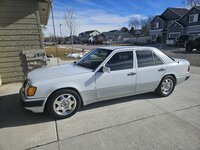Speaking of details, I had pulled the third brake light out months ago, and had been neglecting to do anything with it since I knew it would be best to wait until the tint was done before I reinstalled it. Just like everything else in this car, it was sun-baked and brittle. One tab broke off the rear cover when I tried to remove it.
Over the last few months I've collected up a couple other lights from other cars in the junk yard. None were in good shape, but I was hoping to piece together an acceptable replacement, even if I had to use super glue and vinyl dye to get it looking decent again.
At the end of the day, my original was really the best option I had. It had a couple cracks and was discolored, and had that broken tab on the reflector cap.
I ended up pulling the lens out, and then placing everything in a pot of boiling water for a couple minutes. The theory here is that the heat will allow the stresses built up in the plastic over the years from the sun to relax. This should theoretically make the plastic less brittle.
The plastic did seem a bit more flexible afterwards, bit without testing it to failure before and after, I can't say for sure. One downside is that it did discolor the plastic. The lens got cloudy, and the grey housing got much lighter and milky looking.
I was able to bring the lens back by first taking the haze off everything with green scotch brite. Then I used some light polishing compound to polish the lend back to an acceptable finish. I had to use toothpicks to get into the corners, but eventually it was ok looking. The lens did have some heat damage from the bulb, but it wasn't too bad.
I super glued the cracks in the housing. In the past I've used accelerator spray to help super glue kick off quicker, but I've discovered that this tends to make the glue more brittle. For this repair, I just let it cure naturally overnight.
Next, I used a fine file to knock down the excess glue. Then I carefully sanded to even everything out. The plan was to use Duplicolor Vinyl and Fabric specialty coating in medium gray to match the color. I've used that product before and it's a great color match in the interior of this car. The trick is to clean everything really well, and to also use adhesion promoter.
To clean, I start with dish soap and hot water. Scrub with an old toothbrush. This gets all the old funk off of it. Rinse in hot water, then dry completely. Next, I use non-chlorinated brake parts cleaner with a lint free rag. This is risky and takes some experience. Too much solvent or too much time and you'll melt the plastic. I tend to wet the rag, then wait a few moments for the rag to become just damp. Then, I wipe each area exactly once. After wiping an area, do not touch it. The plastic will soften and it will be easy to leave marks. Once it's all been wiped, it's ready for adhesion promoter.
Now, this is where things went sideways for me. On other plastic parts, I'd been able to just spray 2 or 3 light coats of adhesion promoter, followed by 2 or 3 light coats of color, and everything was great. The third brake light did not like that.
When I sprayed the housing with the adhesion promoter, the solvent contained in the spray attacked the top layer of dye or finish on the brake light housing. As the solvent then evaporated, that layer shrank and cracked.
I walked away for a bit and came back to find it had dried like that. And now had a nasty cracked texture. I decided the only way forward was to sand the whole thing back down. And then try it without the adhesion promoter. I used an orbital sander and 320 grit sanding discs to smooth it back out, then after wiping down with brake clean again, I set it up and sprayed just the color. The same thing happened again.
Here's a picture after that second attempt:
View attachment 182982
I'm not sure, but I assume that the housing is injection molded, and then some kind of finish coat is applied afterwards. Between the boiling, and the solvents, that finish coat had become delicate and was not willing to play nice.
I thought about it a while and decided to try a different approach. I sanded it all down again, and then went and picked up a can of grey Plasti Dip. The Plasti Dip sprayed on nicely and did not attack the plastic or its old finish. It left a nice new finish. The only issue at that point was that the color was too dark.
View attachment 182984
I figured the vinyl spray color might work ok with the Plasti Dip, so I gave that a shot. That ended up working great. Got the color and texture back where it needed to be.
View attachment 182985
I'm bit a fan of retrofit LED bulbs in older cars. There are numerous problems that can be created by their use. That said, the heat created by incandescent bulbs in the thrid brake light ends up damaging theblens and housing over time, so I decided a quality LED bulb was the best option here. I installed a Sylvania LED 7506 bulb in the socket, and then glued the lens back in.
Reinstalled and it looks great and works perfectly.
View attachment 182986


























